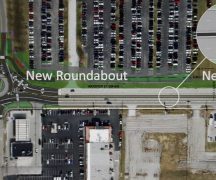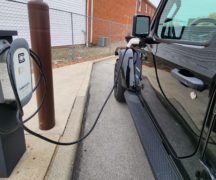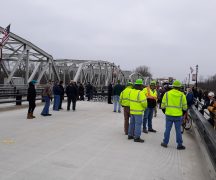By JAN LARSON McLAUGHLIN
BG Independent News
A transportation plan for the region is looking way down the road to help steer efforts for the next 30 years.
To do that, the Toledo Metropolitan Area Council of Governments is taking its show on the road to get public input. On Tuesday, TMACOG staff were in Bowling Green with their large maps and colorful sticky notes.
Their goal is to learn what local residents want in the region’s transportation systems, according to Marissa Bechstein, a TMACOG transportation planner who is coordinating the plan update.
The maps on display showed current public transportation, bike trails, railroads, airports, sidewalks, plus looked ahead toward emerging technologies with electric vehicle charging stations and drone delivery plans.
One map was dotted with sticky notes of suggestions from local residents. One pointed out safety concerns along Ohio 199, where multiple fatal crashes have occurred in the last five years. Another noted the “dangerous weave” of traffic lanes at Interstate 75 and Interstate 475 in Perrysburg. And another suggested a “road diet,” reducing the four lanes to two lanes plus a turn lane, on Mercer Road between East Wooster Street and Ridge Street in Bowling Green.
One map was covered with marks noting fatal crashes and injury crashes in 2019 through 2023.
“We want to identify the most dangerous areas,” said Lisa Householder, transportation planner with TMACOG.
In Wood County, the roads with the most fatal crashes were Route 199, U.S. 6, I-75, Ohio 420 and Bradner Road. The TMACOG study will look at possible solutions to the frequency of serious crashes – including better signage, straightening curvy roads, or installing roundabouts.
“Roundabouts are typically a good solution,” Householder said.
ODOT engineers at the TMACOG open house in Bowling Green, said the fatal crashes at intersections of rural roads are often due to driver distraction. Driving miles without having to stop at a crossroads may lead to driver complacency, said Chris Waterfield, traffic engineer with District 2. Or in some cases, drivers become accustomed to being able to see for miles in both directions, so they get used to running the stop signs or trying to beat traffic.
Waterfield and Travis Bonnett, transportation engineer with ODOT District 2, emphasized the importance of wearing seat belts – which often make the difference between a fatal or injury crash.
“There are a lot of people who still don’t wear seat belts,” Waterfield said. “I’m in support of saving lives.”
Local residents are also expressing their desire for more public transit and bike accommodations.
Wood County residents, especially BGSU students, have voiced support for some type of transit system to the Toledo area. And people on both sides of the Maumee River have shown support for a connection between bike trails in Wood County and Lucas County.
While there is enthusiasm for such a project, the funding is lacking for a connector bridge estimated to cost around $15 million.
“We’re looking at federal funding for that,” said Lance Dasher, transportation planner with TMACOG.
The ”Moving Forward 2055” Regional Transportation Plan is federally required and incorporates all modes of transportation – roads, rails, trails, waterways and the skies.
TMACOG is seeking public input to identify future needs by looking at the current system, identifying new technology and trends, predicting future revenue, and identifying ways to make the transportation system safer, accessible, inclusive, and more efficient.
The organization isn’t looking short-term. It’s gathering information on people’s needs and how they think the regional transportation system should be developed over the next three decades.
“When trying to plan 30 years into the future, it is so important to understand what residents throughout our region want and need in a transportation system,” Bechstein said. “Even though it can be difficult to think so far into the future, we challenge members of the public to think big and provide us with feedback on what they think our transportation system will and should look like.”
A year from now, TMACOG will present its plan to the public, Bechstein said. The public is being asked to share their input, by completing a survey, which takes about five minutes by Nov. 30 at https://www.surveymonkey.com/r/MovingForward2055. To access the survey in Spanish, go to https://es.surveymonkey.com/r/CLVBPS9.





